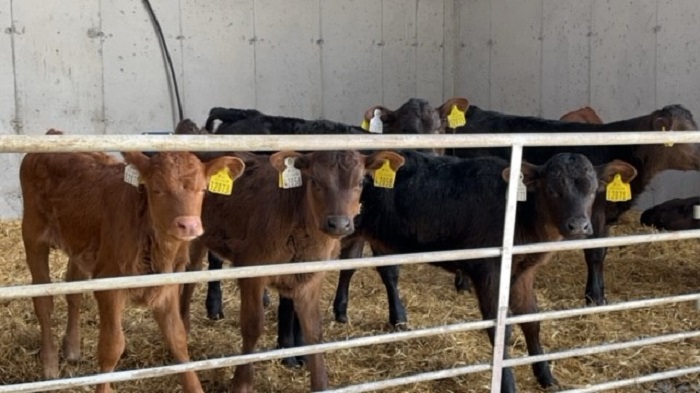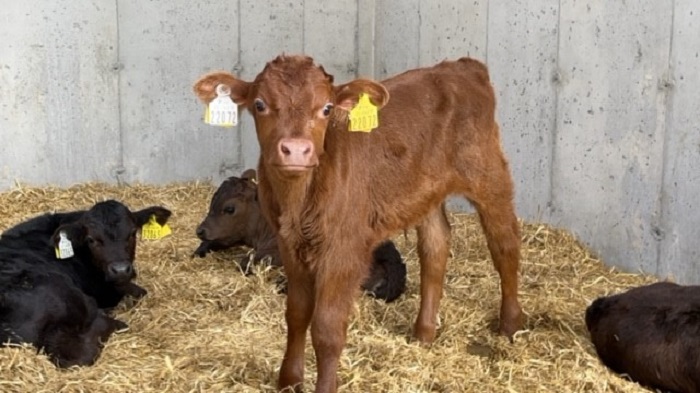01 May 2024
A game of thirds – splitting the beef team by gestation

Milking 170 cows on a 55ha grazing platform in Kilconieron, Co. Galway, David Gannon will follow a beef breeding programme to enhance the beef characteristics and merit of his calves – especially those born in the shoulders of the calving season.
A participant in the Aurivo/Teagasc Farm Profitability Programme, working closely with programme advisor John McCabe and local dairy advisor Thomas Murphy, David’s herd has a maintenance sub-index of €24 and a beef sub-index of -€29 across his cows, meaning the herd sits at the lower end of the national average in terms of beef merit.
David’s preference for a crossbred type cow, stemming from their ability to produce high kilograms of milk solids from his land type of clay and heavy callow soils, requires a huge focus placing on the selection of beef sires. To counteract this, David uses bulls at the higher end of the Dairy Beef Index (DBI). More importantly, he pays particular attention to the beef sub-index of the bulls used.
Breeding and the bull team
Close to 100% AI is used on the farm, with an Angus stock bull used to mop up a small number of heifers. Going forward, David hopes to eliminate the need for a stock bull, as he feels he will be able to produce better quality progeny with AI.
55 of David’s best cows, along with the replacement heifers, will be bred using a sexed semen protocol. Cows not destined to breed replacements will receive a high merit beef AI straw to produce a quality calf, sought after by calf to beef producers.
Angus is the preferred beef breed, as David has repeat customers every year for between 60 and 70 quality Angus calves. This year, however, the plan is to introduce some Limousin and Belgian Blue genetics to further enhance the beef characteristics of his calves, especially at the shoulders of the calving season.

David was cautious of using bulls that could cause difficult calvings and so a team with a calving difficulty range of 2.6% to 5.6% was selected, allowing David to pick suitable bulls to match the cow’s age and size.
For a sire to line out on the cow bull team, the following selection criteria were established:
- A calving difficulty of less than 6%;
- Gestation length of less than three days;
- A beef sub-index of no less than €100;
- Carcass weight of greater than 12kg.
Longer gestation bulls were targeted for use in the first three weeks of the breeding season, with a plan to use a number of Limousin straws in suitable cows that showed signs of heat a week before the main breeding season kicked off on May 1.
For the last three weeks of the breeding season, the use of short-gestation sires becomes more important to avoid an unnecessary extended calving period. At the same time, beef traits couldn’t be compromised, so similar criteria were followed for calving difficulty and carcass weight, but gestation was shortened by one day to ensure calving remained compact.
Table 1: 2024 bull team
| Sire | Calving difficulty | Gestation length | Carcass weight | Beef sub-index | Supplier |
|---|---|---|---|---|---|
| LM2014 | 3.3% | 2.8 days | 28.3kg | €171 | Dovea |
| BB7278 | 4.6% | -2.5 days | 20.4kg | €145 | NCBC |
| BB4329 | 5.6% | 0.2 days | 28.3kg | €169 | Dovea |
| AA4638 | 3.3% | 0.8 days | 16kg | €106 | Dovea |
| AA4087 | 5.2% | 1.3 days | 25kg | €148 | NCBC |
| AA7800 | 3.1% | -2.3 days | 15.7kg | €107 | Bova AI |
| AA7797 | 2.6% | -1.6 days | 17kg | €114 | Bova AI |
| AA6682 | 3.1% | -2.5 days | 12kg | €100 | NCBC |
| Sire for repeat heifers | |||||
| AA4089 | 6.5% (heifer calving difficulty) | -3.6 days | 9.7kg | €102 | NCBC |
Splitting the team
On this farm, it was decided to split the beef bull teams into three periods over the breeding season: a team of bulls for the first four weeks; a team of bulls for the main calving period; and then finally a team of shorter-gestation bulls for the latter end of the breeding season.
Some of the bulls are in both teams. This split means that the gestation length of the bulls would not impact as much on the days in milk for the herd as compared to later on in the season. It was also felt that the use of high carcass merit bulls at this stage would leave a more saleable calf in late February and early March when a large number of calves comes on stream.
Table 2: 2024 beef breeding plan
| Week -1 | Week 1 | Week 2 | Week 3 | Week 4 | Week 5 | Week 6 | Week 7 | Week 8 | Week 9 | Week 10 |
|---|---|---|---|---|---|---|---|---|---|---|
| LM2014 | LM2014 | |||||||||
| BB7278 | BB7278 | BB7278 | BB7278 | BB7278 | BB7278 | |||||
| BB4329 | BB4329 | BB4329 | ||||||||
| AA4638 | AA4638 | AA4638 | ||||||||
| AA4087 | AA4087 | AA4087 | AA7800 | AA7800 | AA7800 | AA7800 | AA7800 | AA7800 | AA7800 | |
| AA7797 | AA7797 | AA7797 | AA7797 | AA7797 | AA7797 | AA7797 | ||||
| AA6682 | AA6682 | AA6682 | AA6682 | AA6682 | AA6682 | AA6682 | AA6682 | AA6682 | AA6682 | |
| AA4089 | AA4089 | AA4089 | AA4089 | AA4089 | AA4089 |
David recently featured on an episode of the Dairy Edge podcast. For more on his beef breeding plan, listen in below:
This article was produced by the Teagasc DairyBeef 500 team, and first appeared on Agriland, as part of the Dairy Beef Index Series.
Also read: Dairy Beef Index Series: Mullen family farm, County Meath
Also read: Producing quality beef calves to ensure repeat custom
Find out more about the Teagasc DairyBeef 500 Campaign
